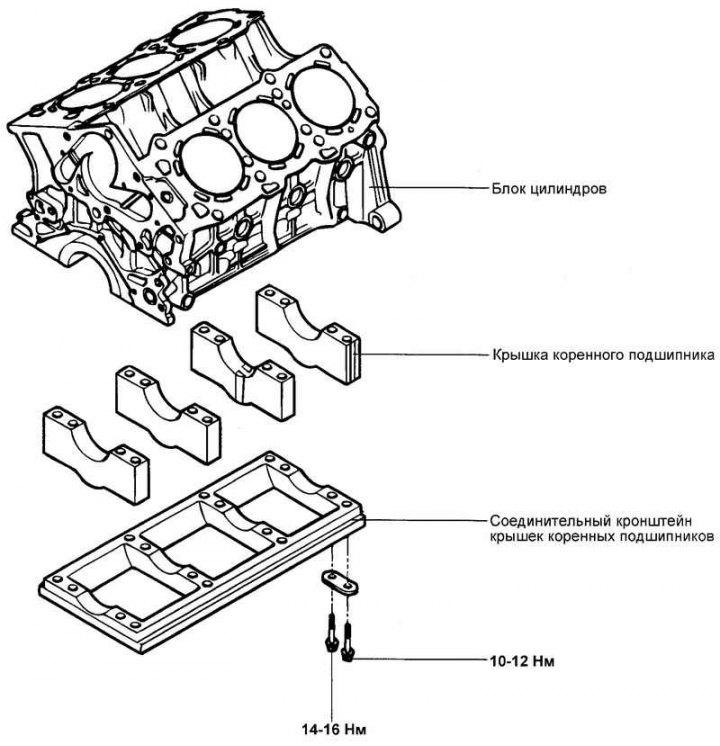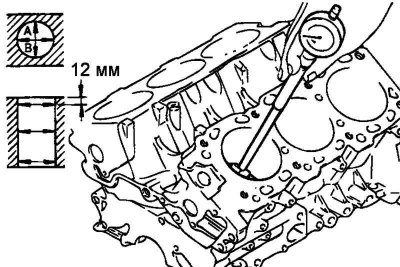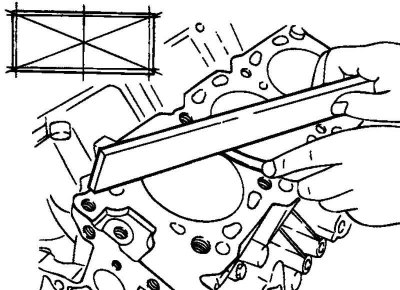
Pic. 2.221. Cylinder Block Components
Disassembly
Remove the cylinder head, timing belt, front cover, transmission drive plate, transmission mounting plate, oil pan, pistons and crankshaft.
Details of disassembly are given below in the relevant sections
Examination
Check the cylinder block for chips, corrosion, scale deposits and rust. Also, check for cracks or other damage. Replace the block of cylinders at detection of considerable defects.

Pic. 2.222. Measuring the diameter of cylinders with a caliper
Measure the diameter of the cylinders with the indicator-caliper in three zones in height in the directions «A» And «IN» (pic. 2.222).
Level 1: TDC of the piston.
Level 2: Midway.
Level 3: BDC of the piston.
If the out-of-roundness (ovality) or the taper of the cylinder is greater than the maximum permissible value, or there are scratches or signs of seizing on the cylinder mirror (badass), then the block cylinders should be bored to the appropriate repair size and honed. After repair of the block of cylinders establish pistons and piston rings of the corresponding repair size.
Nominal value: cylinder diameter - 86.7 mm.
The maximum allowable value of the taper and ovality of the cylinder: no more than 0.02 mm.
If there is an annular wear groove in the stop area of the first compression ring at TDC, remove the groove ridge using a reamer or scraper.

Pic. 2.223. Piston diameter measuring point
When repairing (boring and honing) cylinders to the repair size, calculate the bore diameter of the cylinder so that as a result of the repair, the nominal clearance between the piston and the cylinder is provided. All installed pistons must be of the same repair size. Piston diameter measurements are made at a distance of 12 mm from the skirt cutoff in a plane perpendicular to the axis of the piston pin (pic. 2.223).
Clearance between piston and cylinder: 0.01–0.03 mm.
Check for damage or cracks in the cylinder walls.

Pic. 2.224. Measurement of block flatness for warpage
Using a straightedge and a flat feeler gauge, check the warping of the mating plane of the block under the head. Before checking, remove the remnants of the old gasket and foreign particles from the mating plane (pic. 2.224).
Rated value: flatness - 0.03 mm or less.
Maximum allowable value: flatness - no more than 0.05 mm.
Attention! When restoring the surface by machining, the amount of metal removal should not exceed 0.2 mm
Cylinder boring
When repairing, the maximum cylinder diameter is taken into account.
Note. The oversize mark of the piston is stamped on the firing bottom.
Note. Measure the diameter of the piston installed in this cylinder.
Based on the measured value of the outer diameter of the piston, calculate the bore diameter of the cylinder.
Cylinder bore diameter = piston outer diameter + clearance between piston and cylinder (0.01–0.03 mm) – honing allowance (0.01mm).
Bore all cylinders to the calculated diameter.
Note. When boring, to prevent the occurrence of thermal deformations of the cylinder walls, bore in the order of engine operation.
Honing the cylinder walls until the specified piston-cylinder clearance is achieved.
After honing, recheck the clearance. Nominal value: 0.01 - 0.03 mm.
Note. Only install pistons of the same oversize in the engine
Assembly
Install the parts listed below in the block.
- 1. Crankshaft.
- 2. Automatic transmission drive plate.
- 3. Pistons.
- 4. Cylinder heads.
- 5. Timing belt.
- 6. Front cover.
